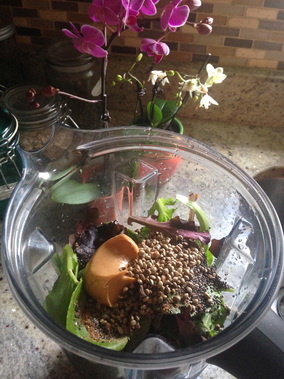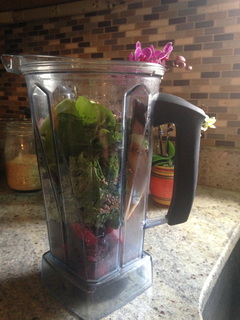 A few years back, smoothies were in. My Facebook feed was filled with exciting ideas for creating awesome and often very different smoothie combinations. What happened? Now my feed is filled with far more intense and hotly debatable topics and smoothies have fallen to the wayside. But less we forget how wonderful and nourishing and versatile they are! With the reemergence of beautifully warm spring weather, brightly colored blossoms, and vibrant green grass and trees, I’m ready to bring back the beauty of the green smoothie (and maybe a few other colors too)! Let’s start with the basics. What is needed to really get down and dirty with a superfood smoothie?
Now for the details - some suggestions for whipping up some awesomely refreshing and nourishing drinkable meals that please kids, adults, and pregnant mommas alike! Greens: Remember to vary these! Different greens provide different nutrients. Spinach is a great base - it’s mild flavor and solid nutrient content makes it a favorite for adding a bright green color and a strong base of micronutrients to your smoothie. It’s full of vitamin A, vitamin C, vitamin K, and manganese. It’s often touted for it’s high iron content but the iron in spinach is not all that absorbable due to it’s high oxalic acid content, which binds with the iron, decreasing it’s absorption. Steam your spinach first and add some vitamin C-rich fruit to your smoothie to increase it’s iron absorption ability. Don’t leave it out - just add another green to enhance the nutrients. Kale is a great source of vitamin K, vitamin A, vitamin C, manganese, copper, vitamin B6, calcium, iron, and more. Kale has three stand-out qualities - it’s antioxidant nutrients, it’s anti-inflammatory nutrients, and it’s anti-cancer nutrients. With kale and collard greens, as with most of the denser dark leafy greens, cooking it well actually helps the body take advantage of it’s nutrients, including the fiber-related components that bind with bile acid in the digestive tract best when steamed, which will then allow these acids to be excreted and aid in lowering cholesterol. You can even add a squeeze of lemon to your kale to enhance it’s phytonutrient concentration (phytonutrients are plant chemicals that protect the plant from fungi, bugs, germs, and other threats and which may help prevent disease and optimize health in humans). Collard greens shine in their anti-cancer properties as well as in their content of vitamin K, vitamin A, manganese, vitamin C, fiber, calcium, choline, vitamin B2, vitamin B6, iron, copper, vitamin E, magnesium, and more. But let’s not stop there! Arugula will add a peppery bite to your smoothie as well as phytonutrients and antioxidants. It’s high folate content, richness in B-complex vitamins, and high levels of vitamin A, vitamin C, vitamin K, as well as adequate content of copper and iron, make it a powerhouse addition to a smoothie. Dandelion will boost your smoothie’s vitamin A, vitamin K, vitamin C, vitamin E, calcium, and iron. Swiss chard is full of antioxidants, anti-inflammatory phytonutrients, vitamin K, vitamin A, vitamin C, magnesium, copper, manganese, potassium, vitamin E, iron, fiber, choline, calcium, and more. Keep exploring new options for your greens - watercress, chines cabbage, beet greens, chicory, green leaf lettuce, romaine, starting out with small amounts as some of the real nutrient dense greens can be quite flavorful (such as the strong spice of mustard greens and turnip greens). Frozen Fruit: Bananas are a favorite of mine for adding some sweetness and a bit of creaminess to a smoothie. I buy a big bunch at a time and freeze those that are starting to turn. Throwing a frozen banana into the blender keeps the smoothie cold and also adds a variety of nutrients - vitamin B6, manganese, vitamin C, potassium (which has the ability to lower blood pressure), fiber, biotin (a B vitamin that metabolizes carbohydrates as well as strengthens hair and nails), and copper. If your bananas aren’t frozen or get eaten long before they’ve made it into the freezer, a handful of frozen berries, pomegranate seeds (high in vitamin C, vitamin K, thiamin, B6, folate, and pantothenic acid), pineapple (rich in vitamin C, manganese, copper, vitamin B6, and vitamin B1), or mango (a good source of vitamin C, vitamin A, B vitamins, and copper) works great too. Superfoods: What makes avocados, berries, red peppers, parsley, pumpkin, orange, lime, grapefruit, kiwi, honey, dark chocolate, broccoli, beans, and sweet potatoes superfoods? There is no legal definition but generally superfoods are considered to be vibrant nutritionally dense foods that are also low in calories. Superfoods boost your body's cancer fighting ability, lower cholesterol, combat heart disease, protect DNA, reduce stress, increase quality of sleep, stabilize blood sugar (www.naturalnews.com). Add these in to your smoothie on a consistent basis and start reaping their amazing benefits. Add-Ins: These are my favorite - just a little something to boost up nutritional value. A tablespoon or two of ground flax (full of healthy fats), chia seeds (a great source of calcium and protein and healthy fats), wheat germ (a powerhouse of B vitamins), hemp seeds (high in healthy fats and easily digestible), or spirulina (a blue-green algae loaded with easily absorbed iron) can turn an average smoothie into an incredibly healthy and satisfying meal. Protein: This is simple - a spoonful of a nut, seed, or legume butter (almond, cashew, peanut, hazelnut, tahini), a quarter cup of an easily digestible bean (white beans work great), or a small handful of nuts or seeds (sunflower, sesame, almonds, brazil nuts) pack a protein punch and round out the mineral content as well. Liquid: This could be anything! Water, herbal teas or infusions (some of my favorite include Blossoming Bellies Pregnancy Tea blend, nettles, oatstraw, hibiscus, and peppermint), a splash of coconut milk (full of healthy fats) mixed with water, coconut water (rich in electrolytes), and even kombucha can change the flavor and texture of your smoothie when you're in need of something different. Try some new things too! Cucumber, apples, carrots, beets, jicama - get creative with these refreshing and earthy flavors! Smoothies are all about experimentation, nutrient density, filling and easily digestible meals, and making healthy snacks portable and palatable. Try out these great combinations below or conjure up your own! Classic Green a handful of spinach two leafs (and stem if your blender can handle it) of kale frozen banana ground flax seed peanut butter water Purple Passion a handful of spinach two leafs of dandelion frozen banana frozen berries chia seeds raw cashews oat straw tea Beach Baby a handful of spinach frozen mango frozen pineapple frozen banana hemp seeds coconut milk coconut water Vitamin Cheat Sheet: Vitamin A: vision, immune system, cell and hair growth B vitamins: cardiovascular health, mood-related hormones, immune system Choline: liver health, brain power Vitamin C: immune system, skin health, wound healing Vitamin D: absorption of calcium, iron, magnesium, phosphate, zinc, mood balance Calcium: bones and teeth Iron: oxygen carrying capacity of hemoglobin Magnesium: heart health, blood pressure, nerve and muscle function, immune system Manganese: bone, skin, blood sugar, Phosphorous: bones and teeth Copper: blood vessels, nerves, immune system, bones, aids iron in formation of red blood cells Fiber: blood sugar regulation, lower cholesterol, lower blood pressure Zinc: immune system, cell division and growth, muscle contractions, wound healing carbohydrate breakdown Sources:
Boutenko, Victoria. Green For Life. Raw Family Publishing, 2005. Print. Healthy Eating. SF Gate, n.d. Web. 5 May 2015. Health Impact News. Health Impact News, 2015. Web. 6 May 2015. Medline Plus. U.S. National Library of Medicine, 2013. Web. 6 May 2015. Mercola.com. Dr. Joseph Mercola, n.d. Web. 6 May 2015. Julius, Sonny. Natural News. Natural News Network, 11 January 2008. Web. 6 May 2015. Olson, Cathe. The Vegetarian Mother's Cookbook. Nipomo, CA: GOCO Publishing, 2005. Print. Park, Alice. Time. n.p., 6 June 2014. Web. 5 May 2015. Self Nutrition Data. Conde Nast, 2014. Web. 3 May 2015. The World's Healthiest Foods. George Mateljan Foundation, n.d. Web. 5 May 2015.
0 Comments
|
AuthorAs the Philadelphia birth world blooms bigger and brighter, I think it's time I start putting some of the insightful questions I've received and information I've research into a public journal. I hope you'll find this inspiring, empowering, and totally enjoyable. Archives
February 2021
Categories |



 RSS Feed
RSS Feed